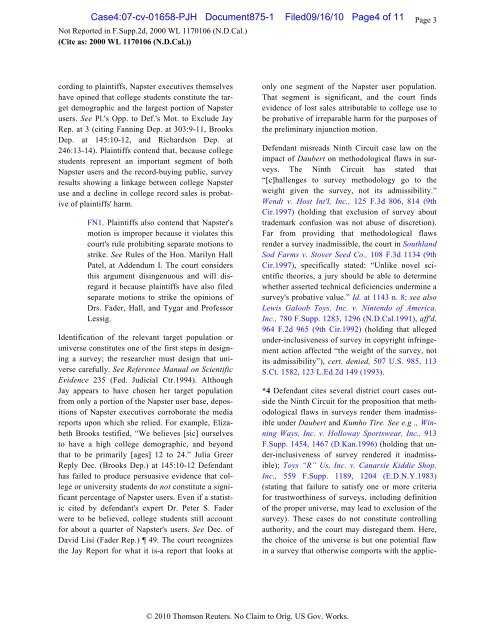exhibit 2 - SAP Lawsuit Portal
exhibit 2 - SAP Lawsuit Portal
exhibit 2 - SAP Lawsuit Portal
You also want an ePaper? Increase the reach of your titles
YUMPU automatically turns print PDFs into web optimized ePapers that Google loves.
Case4:07-cv-01658-PJH Document875-1 Filed09/16/10 Page4 of 11<br />
Not Reported in F.Supp.2d, 2000 WL 1170106 (N.D.Cal.)<br />
(Cite as: 2000 WL 1170106 (N.D.Cal.))<br />
cording to plaintiffs, Napster executives themselves<br />
have opined that college students constitute the target<br />
demographic and the largest portion of Napster<br />
users. See Pl.'s Opp. to Def.'s Mot. to Exclude Jay<br />
Rep. at 3 (citing Fanning Dep. at 303:9-11, Brooks<br />
Dep. at 145:10-12, and Richardson Dep. at<br />
246:13-14). Plaintiffs contend that, because college<br />
students represent an important segment of both<br />
Napster users and the record-buying public, survey<br />
results showing a linkage between college Napster<br />
use and a decline in college record sales is probative<br />
of plaintiffs' harm.<br />
FN1. Plaintiffs also contend that Napster's<br />
motion is improper because it violates this<br />
court's rule prohibiting separate motions to<br />
strike. See Rules of the Hon. Marilyn Hall<br />
Patel, at Addendum I. The court considers<br />
this argument disingenuous and will disregard<br />
it because plaintiffs have also filed<br />
separate motions to strike the opinions of<br />
Drs. Fader, Hall, and Tygar and Professor<br />
Lessig.<br />
Identification of the relevant target population or<br />
universe constitutes one of the first steps in designing<br />
a survey; the researcher must design that universe<br />
carefully. See Reference Manual on Scientific<br />
Evidence 235 (Fed. Judicial Ctr.1994). Although<br />
Jay appears to have chosen her target population<br />
from only a portion of the Napster user base, depositions<br />
of Napster executives corroborate the media<br />
reports upon which she relied. For example, Elizabeth<br />
Brooks testified, “We believes [sic] ourselves<br />
to have a high college demographic, and beyond<br />
that to be primarily [ages] 12 to 24.” Julia Greer<br />
Reply Dec. (Brooks Dep.) at 145:10-12 Defendant<br />
has failed to produce persuasive evidence that college<br />
or university students do not constitute a significant<br />
percentage of Napster users. Even if a statistic<br />
cited by defendant's expert Dr. Peter S. Fader<br />
were to be believed, college students still account<br />
for about a quarter of Napster's users. See Dec. of<br />
David Lisi (Fader Rep.) 49. The court recognizes<br />
the Jay Report for what it is-a report that looks at<br />
© 2010 Thomson Reuters. No Claim to Orig. US Gov. Works.<br />
Page 3<br />
only one segment of the Napster user population.<br />
That segment is significant, and the court finds<br />
evidence of lost sales attributable to college use to<br />
be probative of irreparable harm for the purposes of<br />
the preliminary injunction motion.<br />
Defendant misreads Ninth Circuit case law on the<br />
impact of Daubert on methodological flaws in surveys.<br />
The Ninth Circuit has stated that<br />
“[c]hallenges to survey methodology go to the<br />
weight given the survey, not its admissibility.”<br />
Wendt v. Host Int'l, Inc., 125 F.3d 806, 814 (9th<br />
Cir.1997) (holding that exclusion of survey about<br />
trademark confusion was not abuse of discretion).<br />
Far from providing that methodological flaws<br />
render a survey inadmissible, the court in Southland<br />
Sod Farms v. Stover Seed Co., 108 F.3d 1134 (9th<br />
Cir.1997), specifically stated: “Unlike novel scientific<br />
theories, a jury should be able to determine<br />
whether asserted technical deficiencies undermine a<br />
survey's probative value.” Id. at 1143 n. 8; see also<br />
Lewis Galoob Toys, Inc. v. Nintendo of America,<br />
Inc., 780 F.Supp. 1283, 1296 (N.D.Cal.1991), aff'd,<br />
964 F.2d 965 (9th Cir.1992) (holding that alleged<br />
under-inclusiveness of survey in copyright infringement<br />
action affected “the weight of the survey, not<br />
its admissibility”), cert. denied, 507 U.S. 985, 113<br />
S.Ct. 1582, 123 L.Ed.2d 149 (1993).<br />
*4 Defendant cites several district court cases outside<br />
the Ninth Circuit for the proposition that methodological<br />
flaws in surveys render them inadmissible<br />
under Daubert and Kumho Tire. See e.g ., Winning<br />
Ways, Inc. v. Holloway Sportswear, Inc., 913<br />
F.Supp. 1454, 1467 (D.Kan.1996) (holding that under-inclusiveness<br />
of survey rendered it inadmissible);<br />
Toys “R” Us, Inc. v. Canarsie Kiddie Shop,<br />
Inc., 559 F.Supp. 1189, 1204 (E.D.N.Y.1983)<br />
(stating that failure to satisfy one or more criteria<br />
for trustworthiness of surveys, including definition<br />
of the proper universe, may lead to exclusion of the<br />
survey). These cases do not constitute controlling<br />
authority, and the court may disregard them. Here,<br />
the choice of the universe is but one potential flaw<br />
in a survey that otherwise comports with the applic-


